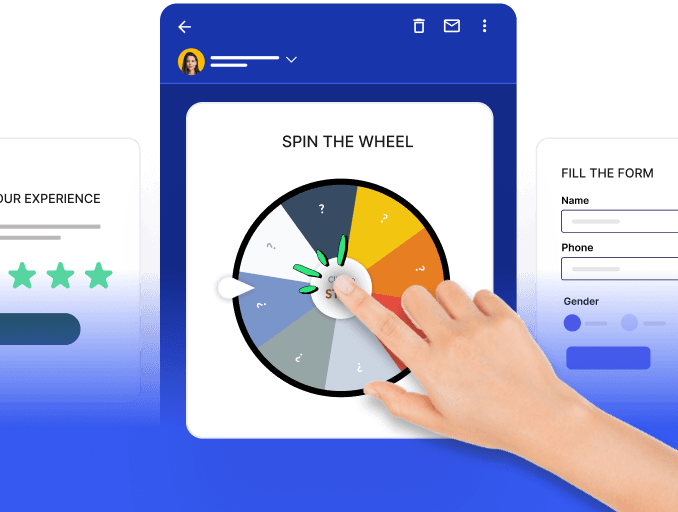When people decide to buy something or use a service, they go through a series of steps before making the final purchase. If there’s friction or if, at any stage, the potential customers don’t feel satisfied, they might decide not to choose the product or service you offer. So, ecommerce businesses must engage customers and meet or exceed their expectations at every stage of the journey. This is why having an engaging and optimized customer journey map is important.
This guide discusses all the touchpoints and different stages of an ecommerce customer journey and how you can identify where your potential customers are dropping off. It also discusses how you can improve the overall experience for your potential and existing customers.
Table of contents
What are the stages of an ecommerce customer journey?
The ecommerce customer journey can be divided into five different stages. You must know what these stages are, how they affect customer experiences and their relationship with you, and how you can improve them at every level. Let’s take a look at each stage one by one.
Let’s have a look at the stages of the customer journey so you can have a better understanding of your customer's experiences on your ecommerce platform.
Stage 1: Awareness
The awareness stage is when people first learn about your product, service, or brand. This is the stage during which they realize they need or want something.
This stage gives you insight into how people are finding you. This can be because of your SEO strategy, paid marketing, or social media. You can also learn what people are looking for. You can even use an on-site survey that asks them how they found you.
If you’re not able to reach enough users or have users who don’t proceed past this stage, it could be because of one of these reasons.
- You’re using marketing channels that your target audience doesn’t use.
- You’re advertising on the platforms where your target audience is not there.
- You’re not offering anything unique and don’t stand out from the competition.
- Your messaging about your offerings is unclear or not engaging.
Stage 2: Consideration
The consideration stage is when potential customers actively look into different offerings to solve their needs or problems. They compare products, services, and brands to see which one suits them best. In this stage, customers engage with your products, by viewing them, going through the product descriptions, asking questions and so on.
This stage will give you an insight into customer preferences, like what kind of products are the users looking for, how they browse through your products, what kind of product thumbnails on listing pages work for you and so on. You can use session recordings and heatmaps to better understand where your customers focus more.
If customers are leaving or dropping off at this stage, it may be because of one of these reasons:
- The cost of your products is too high.
- Unclear or insufficient information about products.
- The customers don’t trust your brand.
- A competitor is offering similar products at better prices.
Stage 3: Conversion
The conversion stage is when potential customers decide to buy a product or service after thoroughly researching the market.
This gives you an idea that your efforts are in the right direction and helps you improve or streamline your efforts. This part of the journey is also a great time to run post-purchase survey on your website or even send an AMP email with a rating scale where customers can rate their purchasing experience within the email itself.
If you see that customers are dropping off at this stage, that is, during the conversion, it can be because of one of the following reasons:
- The checkout process is too long and complex.
- The customers aren’t sure if they’ll get the product after they place an order.
- The cost of shipping is too high.
- You’re not offering the mode of payment that the customer wants.
Stage 4: Retention
Retention is about keeping customers engaged with a product, service, or brand over time, building loyal customers, brand loyalty, and long-term relationships. This is the stage in which the customers keep coming back to you and purchasing from you.
The data from this stage will allow you to determine whether the product that a customer purchased from you met their expectations. You can also learn what different activities or offers work with your customer base.
If you’re unable to retain your customers or if they don't come back after the first purchase, it might be because of the following reasons.
- Poor or lack of customer support.
- The products you sell are of poor quality.
- There is no motivation to buy, like sales, discounts or offers.
Stage 5: Advocacy
Advocacy is when satisfied customers actively promote and recommend your product or brand to others in their network. They share their positive experiences with others.
This stage gives you an idea of how well you’re doing. If you have customers who advocate your products and brand, it might be because you’re providing exceptional customer service, good quality products, value for money and so on. You can try social media listening tools to track mentions of your brand.
If you don’t see your customers advocating your brand, it might be because:
- You’re not doing anything exceptional.
- You’re not providing any incentives.
Why is a good customer journey important?
A good customer journey is vital for business success. It boosts conversions by meeting customer satisfaction and expectations and speeds up the journey from the awareness stage to the advocacy stage, leading to faster conversions and building lasting customer relationships. Here’s why you want to have a customer journey that is good.
- Customer retention: A good journey makes customers happy at every next step, providing them with a good user experience and keeping them satisfied and coming back for more. This leads to more engagement, increased loyalty and repeat purchases from repeat customers.
- Increased sales A good customer journey reduces the friction for a potential customer to become a customer. This increases conversion rates, sales and profits.
- Word-of-mouth marketing: Satisfied customers tell others about their experience, promoting your brand and bringing in new customers.
- Stand out from competitors: If you provide your customers with a good customer journey experience, it’ll help you to stand out from the pool of competitors. Customer persona are often more inclined to choose a brand that provides the best customer experience.
Strategies to improve customer engagement and retention
The first step in improving your ecommerce customer journey is to identify the stage at which customers churn. Once you’ve identified that, you can figure out the reason for churning and experiment with different strategies to reduce the drop-off rate. Here are some strategies that you might want to consider for improving your overall customer journey.
Connect at every stage
Make sure that you interact with your customers at every point or at every stage along their journey. Whether it's catching their eye with ads in the awareness stage or helping them make the right choice by recommending products in the consideration stage, it improves the overall user experience and keeps your customers engaged.
Optimize for all devices
Since a lot of people use mobile phones and tablets to browse through online stores, make sure your website is optimized for all devices. This will allow you to provide your customers with a good customer experience on all devices and make it accessible. You must test your website on different platforms and devices to identify and fix any glitches and you can even consider launching an ringcentral app for your ecommerce store.
Proactive customer support
Have a good customer support team that can solve customer problems proactively. Train them well and provide access to the right kind and amount of customer data so they are well-equipped to identify and solve customer issues quickly and accurately. You can even use an AI chatbot to help you answer usual queries and cut down on the volume of customer support calls.
Provide personalized experiences
Personalize the customer experience for each customer by using things like tailored emails special offers based on their interests and recommended products on product pages based on their purchase history. Use customer data to better understand your customers and provide them with personalized content and product recommendations based on their age, gender, location, preferences and so on. This will make their shopping experience better and keep them coming back for more.
Gather and use more data
Keep collecting data about what your customers like and don’t like. This will help you better understand your customer base, the market and the competition. It’ll also help you in better marketing and utilizing your resources in the right place at the right time.
Conclusion
To make your business is successful, it's important to focus on improving every step of the ecommerce customer journey mapping. A good customer journey map can help you identify and set better and more realistic business goals. This can be done by using analytics tools and engaging with your prospective customers. A smooth user experience can help you overcome issues like shopping cart abandonment. It's also important to align your marketing strategies with the customer journey and offer an easy-to-use experience across different channels. By doing these things, you can create a successful ecommerce customer journey map that helps your business grow.







